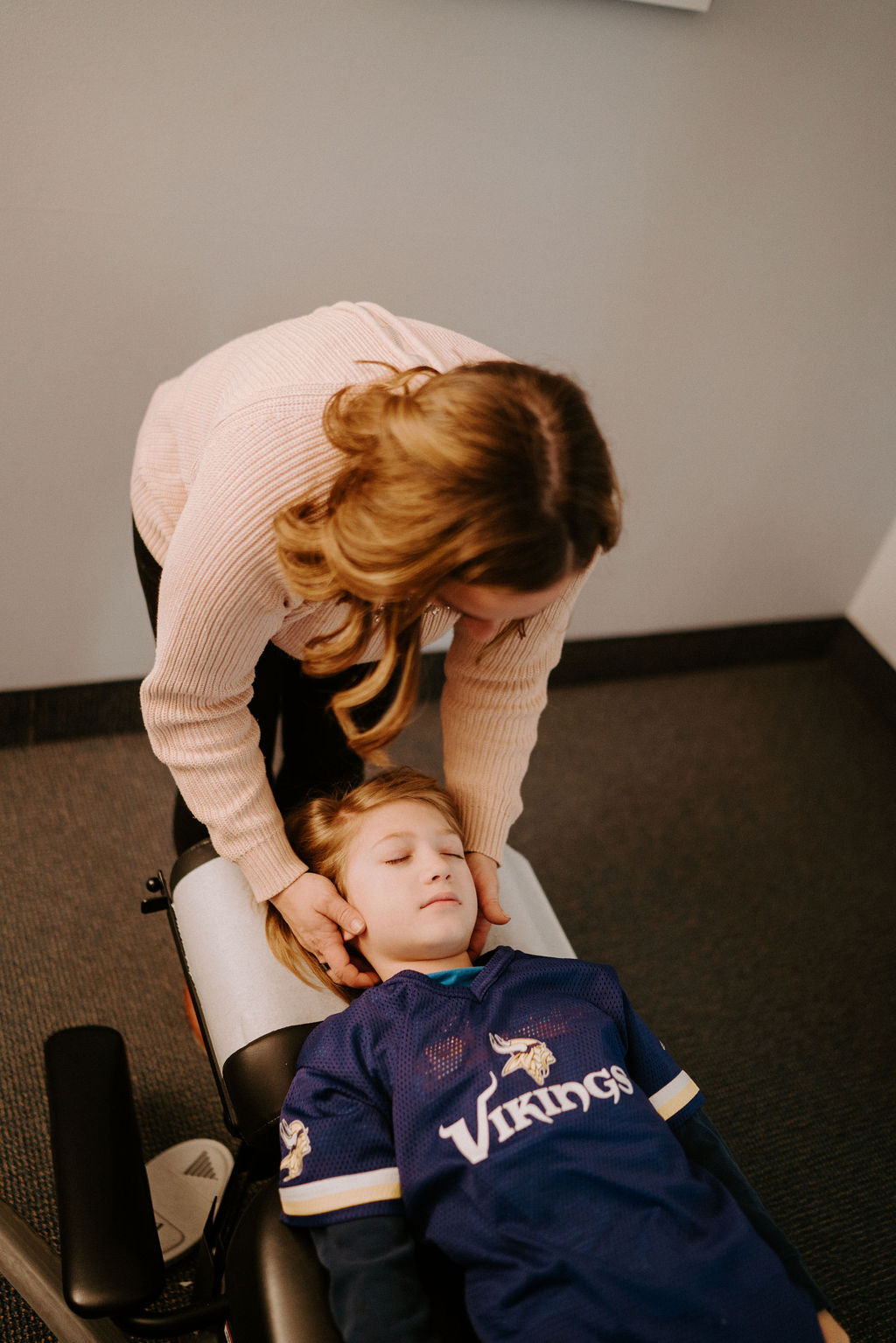WElcome TO
Explore our blog that focuses on holistic care for any and all ages - pediatric well-being, pre/post-natal health, and adult vitality.
THE BLOG

Every winter, you watch it happen again.
As the days get shorter, your child’s motivation starts to fade. Their energy drops. Emotions become harder to manage. The meltdowns that seemed under control in September are suddenly happening multiple times a day. The anxiety you thought you had a handle on comes roaring back.
You’ve heard the medical explanation: Seasonal Affective Disorder. Reduced sunlight. Chemical imbalances. The solution? Try a light box. Add another supplement. Maybe consider medication.
But here’s the question that keeps nagging at you: Why does your child struggle so predictably every single year while their sibling or classmates seem fine?
The answer changes everything about how you approach your child’s health—not just in winter, but year-round.
The Pattern You Can’t Ignore
Let’s paint a picture you probably know all too well.
In August, things are manageable. Your child is sleeping reasonably well. Digestion is okay. Yes, there are challenges, but you’ve found your rhythm. You’re managing.
Then October hits. November arrives. And suddenly, everything falls apart.
Sleep becomes a nightly battle. Stomach issues return with a vengeance. The behavioral challenges you thought you’d gotten past come flooding back. It’s like watching your child slip away, and no matter what you try—earlier bedtimes, dietary changes, consistent routines—nothing seems to help.
This isn’t a coincidence. It’s not bad parenting. And it’s definitely not “all in your head.”
Your child’s nervous system is telling you something critical: it’s running on empty.
Understanding Your Child’s Nervous System “Battery”
Think about your smartphone for a moment. When it’s fully charged, it handles everything you throw at it—calls, apps, videos, navigation—without breaking a sweat. But when that battery gets low? Suddenly, even basic functions become a struggle.
Your child’s nervous system works the same way.
The Autonomic Nervous System is like having two pedals in a car: a gas pedal (the Sympathetic Nervous System) that activates when your child needs to respond to challenges, and a brake pedal (the Parasympathetic Nervous System) that helps them rest, digest, sleep, and stay emotionally balanced.
A healthy, regulated nervous system, helps your child shift smoothly between these states. They can “gas it” when they need to focus at school or handle disappointment, then easily hit the “brake” to calm down, fall asleep, and recover.
But here’s what’s happening with your child: their gas pedal is stuck down, and their brake pedal barely works.
This is called sympathetic dominance, and it’s absolutely exhausting. Imagine trying to drive everywhere with your foot on the gas and barely any ability to brake. That’s what your child’s nervous system is doing 24/7.
Why Seasonal Changes Hit So Hard
Now, let’s talk about why fall and winter become the breaking point.
Seasonal transitions aren’t just about colder weather and pretty leaves. Your child’s nervous system has to do serious adaptation work:
- Adjusting circadian rhythms to drastically different light patterns
- Maintaining neurotransmitter production despite reduced sunlight exposure
- Regulating body temperature in colder conditions
- Supporting immune function during cold and flu season
For a child with a healthy nervous system reserve—a fully charged battery—these adaptations happen automatically in the background. They might notice the shorter days, but they don’t feel overwhelmed by them.
But for your child, whose nervous system is already maxed out? These seasonal demands become the final straw. There’s simply nothing left in reserve. The battery hits zero, and that’s when you see everything crash: sleep, behavior, digestion, emotional regulation—all of it.
This is what we call neurological exhaustion, and it explains why your child struggles every single winter.
The “Perfect Storm” That Started Years Ago
Here’s what most doctors won’t tell you: your child’s seasonal vulnerability didn’t start this fall. It began much, much earlier—possibly before they were even born.
Let us walk you through The Perfect Storm that creates this nervous system depletion:
Before Birth: The Programming Phase
If you experienced significant stress during pregnancy—whether from work pressure, relationship challenges, financial worry, or health concerns—your developing baby was exposed to elevated cortisol and stress hormones. This essentially programmed their nervous system to expect a stressful environment. Their little system was set to “high alert” before they even took their first breath.
Birth: The Physical Stress Point
Birth interventions—C-sections, forceps, vacuum extraction, or extended labor—can create physical stress to your baby’s upper cervical spine and vagus nerve pathway. This isn’t about blame; these interventions are often medically necessary. But they can impact how your child’s nervous system develops and functions.
Early Years: The Compounding Factors
Then came the early childhood stressors: colic that wouldn’t quit, reflux that made feeding a nightmare, recurring ear infections, and rounds of antibiotics. Each of these added more stress to an already vulnerable system.
Those antibiotics? They disrupted your child’s gut microbiome, which directly affects nervous system regulation. (Yes, gut health and brain health are intimately connected.)
Ages 3-7: When Labels Appear
By preschool or early elementary, the diagnostic labels started appearing: ADHD, autism, anxiety, sensory processing disorder, and behavioral challenges. But here’s the truth: the nervous system dysfunction was there all along. The signs just became more evident as life demands increased—and seasonal transitions exposed what was already struggling.
What This Means for Your Family
I know this might feel overwhelming. You might be thinking, “Great, so my child’s nervous system has been struggling since birth. Now what?”
Here’s the empowering part: your child’s seasonal struggles aren’t about weakness, bad brain chemistry, or being “broken.” They’re a sign that their nervous system has lost its reserve capacity and needs support to heal.
And the nervous system—your child’s nervous system—is designed to heal, recover, and regulate when given the proper support.
A Different Approach for This Winter
You’ve probably tried everything: light therapy boxes, vitamin D supplements, melatonin for sleep, dietary changes, and behavioral strategies. And maybe some of these helped a little. But they didn’t address the root issue—your child’s dysregulated nervous system.
This is where Neurologically-Focused Chiropractic Care comes in.
At Rochester Chiropractic and Wellness we offer a specialized approach to work directly with your child’s nervous system, helping to release the physical stress patterns that keep them stuck in “gas pedal down, no brake” mode. It’s about restoring your child’s neurological resilience—recharging that battery so they have the capacity to adapt to seasonal changes without falling apart.
Parents tell us they can’t believe the difference after just a few adjustments: better sleep, fewer meltdowns, improved digestion, and more emotional stability. Not because we’re “fixing” seasonal depression, but because we’re helping their child’s nervous system finally shift out of survival mode and into thriving mode.
Your Next Step
You don’t have to resign yourself to another difficult winter. You don’t have to keep watching your child struggle every year, feeling helpless and frustrated.
You can take charge of your child’s health by addressing the root cause—their nervous system’s depleted capacity.
Here’s what you can do:
- Recognize the pattern – If your child struggles predictably every fall and winter, their nervous system is telling you it needs support
- Stop blaming yourself – This isn’t about anything you did wrong; it’s about understanding what your child’s system needs
- Seek specialized care – Make an appointment for a consultation at RCW.
- Trust the process – Nervous system healing takes time, but the changes can be profound
This winter can be different. Your child can have the energy, emotional stability, and resilience to not just survive the darker months, but truly thrive through them.
You’ve been an incredible advocate for your child, trying everything to help them feel better. Now it’s time to address what’s been at the root of their struggles all along—and finally give their nervous system the support it’s been desperately asking for.

If your baby’s head is stuck tilting to one side, you’ve probably been told it’s just a tight muscle. “Stretch it out, do some tummy time, and wait it out,” they say.
But here’s what most pediatricians won’t tell you: torticollis isn’t just about tight muscles. It’s about what happened to your baby’s nervous system during birth.
You’re Not Alone in This Journey
We see this pattern week after week. A mom comes in exhausted, holding a baby who cries during every diaper change, struggles to nurse on one side, and can’t seem to get comfortable no matter what position you try. The pediatrician noticed the head tilt at the 2-month checkup, referred you to physical therapy, and sent you home with stretching exercises that make your baby scream.
Those stretches aren’t working because they’re treating the symptoms, not the root cause. And while you’re waiting and stretching, that subluxation in your baby’s upper spine is affecting far more than just their neck. It’s impacting their ability to eat, sleep, drain fluid from their ears, and hit developmental milestones.
Nathan’s Story: From Struggle to Thriving
Let us tell you about Nathan. His mom brought him in after a traumatic emergency C-section left him with torticollis, plagiocephaly (flat head), digestive issues, and eczema covering his face. He was locked up from his neck all the way down to his lower back. The tight neck muscles caused ear misalignment, leading to repeated ear infections that began at just a few months old.
Nathan’s occupational therapy wasn’t helping. He was even fitted for a helmet to correct the flat spot on his head, but he still looked miserable and uncomfortable all the time. He couldn’t hit his milestones because his entire system was stuck in overdrive.
Within the first month of Neurologically-Focused Chiropractic Care, Nathan’s digestive issues and eczema cleared up. By month two, everything changed. He started sitting up, crawling, pulling himself to stand, and he hasn’t had an ear infection since starting care.
Understanding Torticollis: It’s More Than Meets the Eye
1. Torticollis Is a Neurological Problem, Not Just a Tight Muscle
When doctors diagnose torticollis, they’re looking at the obvious sign: your baby’s head tilts to one side with their chin pointing the other way. They see tight muscles and a limited range of motion. But what they’re missing is what’s happening underneath.
Torticollis happens because of subluxation. Subluxation has three parts:
- Misalignment within the neurospinal system
- Abnormal tension or fixation within these neurospinal segments and regions
- Neurological interference and imbalance, where the nervous system gets stuck sending stress signals instead of calm, coordinated ones
Think of it like a computer with too many tabs open. When your baby’s nervous system is overwhelmed with stress signals from that subluxation, everything slows down or crashes. Their body can’t coordinate properly, muscles stay tight, and they’re stuck in fight-or-flight mode.
2. Birth Trauma Is the Most Common Cause
The amount of pulling, twisting, and pressure placed on a baby’s head and neck during birth interventions is significant. Forceps delivery, vacuum extraction, and even C-sections can create subluxation in the upper cervical spine.
Add that to difficult positioning in the womb, being stuck in the birth canal, or a long labor, and you’ve got what we call the Perfect Storm. These layers of stress compound on each other, and the result is a nervous system that can’t regulate properly.
3. Why Stretching Alone Doesn’t Work
Physical therapy stretches work on the muscles, but they don’t address the subluxation that creates the tension in the first place. It’s like trying to push a car with the parking brake on.
Many parents tell us the stretches make their baby cry and seem to make things worse. That’s because when the nervous system is stuck in stress mode, any additional discomfort just adds to the tension. The body fights back instead of relaxing.
When you release the subluxation first with gentle chiropractic adjustments, the nervous system can finally calm down. Then the stretches and positioning exercises actually work because the parking brake is off.
4. The Hidden Consequences of Unresolved Torticollis
Here’s what concerns us most: when torticollis isn’t fully resolved at the neurological level, it doesn’t just go away.
That subluxation can contribute to:
- Ear infections because tight neck muscles affect Eustachian tube drainage
- Respiratory infections like croup and RSV because the body can’t move mucus and secretions properly
- Developmental challenges as kids grow, including gross motor delays, fine motor challenges, sensory processing issues, and even ADHD
The foundation wasn’t stable, so development gets harder at every stage.
There’s Hope: A Gentle, Effective Path Forward
If your baby has torticollis, you don’t have to choose between painful stretches and just waiting it out. There’s a gentle, effective approach that addresses the root cause.
Advanced INSiGHT scans can pinpoint exactly where the subluxation is located and determine its severity. Then, with safe and gentle adjustments, the tension can be released and balance restored to your baby’s nervous system. Parents often see changes within just a few visits.
Sometimes our little ones just get stuck in stress mode, and when we ease that nervous system tension, everything can shift.
Ready to Help Your Baby Thrive?
At Rochester Chiropractic and Wellness, we believe your baby deserves to feel comfortable, develop on track, and thrive. And you deserve to feel empowered and supported on this journey. We want to help. Don’t wait for torticollis to resolve on its own; give us a call today to schedule a consultation for your baby.

Your child has been sick six times since September. You’ve tried everything — vitamins, essential oils, probiotics, even that expensive immune booster your friend swears by. But nothing seems to work. The antibiotics clear one infection just in time for the next one to start. You’re exhausted, your child is miserable, and deep down you know there has to be a better way.
Here’s what nobody’s telling you: You’re doing everything right, but in the wrong order.
It’s like trying to remodel a house while the foundation is cracking. No matter how beautiful the upgrades, nothing will hold if the base isn’t solid. The same is true for your child’s health. You can add all the supplements and remedies you want, but if their nervous system — their foundation — is stuck in stress mode, nothing else can work properly.
The truth is, your child is stuck in a pattern that can be shifted once you understand the right sequence.
The Medicine Cabinet Shuffle
If you’re like most parents we see, you’ve been caught in what we call the “medicine cabinet shuffle” — trying remedy after remedy, therapy after therapy, with limited results. You’ve been told your child will “grow out of it” or to just keep adding more interventions.
But here’s what the research shows: children who receive antibiotics before age two are more likely to struggle with asthma, respiratory allergies, eczema, celiac disease, obesity, and ADHD later in life.
Now, let’s be clear: antibiotics aren’t inherently bad. They can absolutely be lifesaving. The problem is we’re treating the symptoms without ever asking why the immune system is struggling in the first place.
It’s like having a bucket with holes in it. You can keep pouring water in, but until you patch the holes, you’ll never fill the bucket.
Your Child’s Nervous System: The Air Traffic Controller
Here’s the game-changer that most parents never learn: Your child’s nervous system is like the Air Traffic Controller of their entire body — it coordinates every other system, especially the immune system.
When the nervous system is stressed and stuck in “fight or flight” mode, it cannot coordinate proper immune responses, digestion, or sleep. This is why supplements and remedies often fail — you’re trying to boost a system that’s fundamentally dysregulated.
Why Most Approaches Fail
Most parents are taught to attack the symptoms, not address root causes. It’s like pushing a car with the parking brake on — therapies and remedies can’t work when the nervous system is locked in stress mode.
The “Perfect Storm” of modern childhood — prenatal stress, birth interventions, early antibiotics, and environmental toxins — creates a stressed nervous system from day one. Without addressing this neurological stress first, you’re just managing symptoms, not building health.
The Four Pillars (In The Right Order)
When you get the foundation right first, everything else can finally fall into place. Here are the four pillars that support your child’s health — and they must be addressed in this specific order:
1. Sleep Comes First
Sleep is when the body does its deepest healing and immune system regulation. Consistent poor sleep in children contributes to immune problems, focus challenges, anxiety, and depression. If your child isn’t sleeping well, nothing else you do will be as effective as it could be.
2. Exercise and Play
Movement isn’t just about burning energy. Exercise and play activate brain pathways critical for learning, immune response, and nervous system regulation. When kids move their bodies, they’re literally training their brains and immune systems to function better.
3. Clean Eating
This means focusing on nutrient-dense foods while minimizing processed sugars and chemicals. But here’s the relief: 80/20 consistency beats perfection. You don’t need to be perfect. You just need to be consistent enough that your child’s body has what it needs to thrive.
4. Neurologically-Focused Chiropractic Care
This is the key that unlocks everything else. Neurologically-Focused Chiropractic Care helps restore balance to the nervous system, releasing that parking brake so all your other efforts can actually work. When the Air Traffic Controller is functioning properly, everything else falls into place.
Building Real Resilience
The goal isn’t just to stop the current cold or infection. The goal is to build real resilience — to help your child’s body handle whatever comes its way without constant illness.
When you address the nervous system first and follow the four pillars in order, you’re not just managing symptoms. You’re giving your child’s body the foundation it needs to heal itself and stay strong.
Your Next Step
If you’re ready to stop the endless cycle and build your child’s health from the foundation up, it’s time to take a different approach. At Rochester Chiropractic and Wellness, we understand that your child doesn’t need more labels or medications — they need their nervous system to shift from stressed to regulated. We are ready for your call, so please don’t wait to contact us today to schedule a consultation for your child.
It’s time to stop pushing that car with the parking brake on. When you release it, you’ll be amazed at how naturally your child can thrive!






